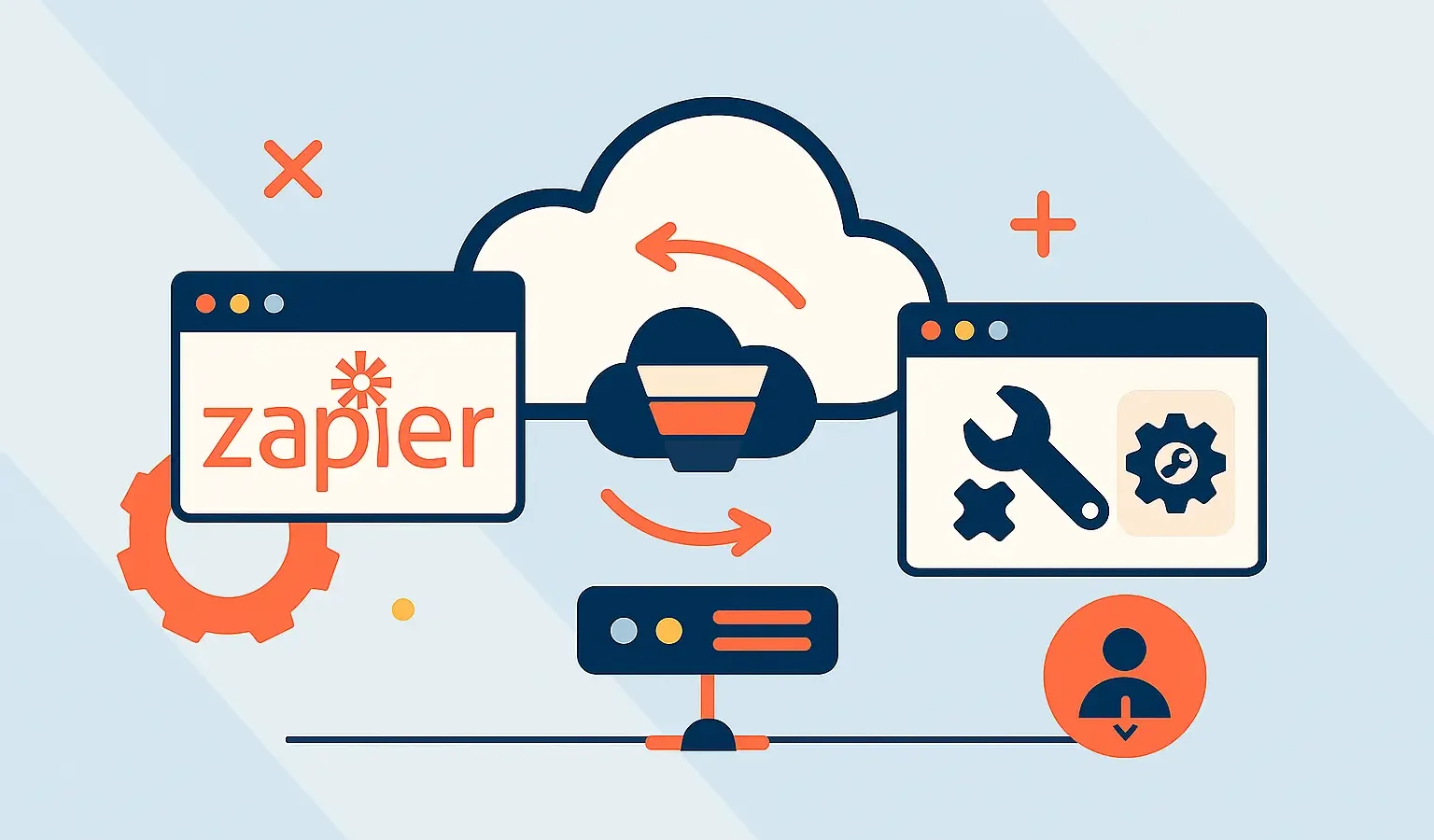Let’s be honest: Zapier is the duct tape of the internet.
This is not an insult. Duct tape is incredible. If you need to fix a leaky hose or patch a hole in a tent, duct tape is your best friend. In the business world, if you need to send a Slack message every time a Google Form is filled out, Zapier is a miracle.
But you wouldn’t use duct tape to attach the wing of an airplane.
Yet, that is exactly what thousands of growing businesses are doing. They are running mission-critical, high-volume operations on a web of fragile “Zaps” that were never designed to handle enterprise scale.
Eventually, the tape starts to peel. Tasks fail. Data goes missing. Your operations manager spends more time debugging JSON errors than actually managing operations.
There is a distinct moment in every company’s growth when “no-code” becomes “no-go.” You need to know when to stop patching the leaks and start building a real integration pipeline.
Key Takeaways
- Zapier is a starter tool, not a scaler tool: It is fantastic for prototyping and simple tasks, but it becomes a liability as complexity and volume grow.
- Cost vs. Value: There is a tipping point where paying for premium Zapier tasks becomes significantly more expensive than owning a custom solution.
- Logic limitations: No-code tools struggle with complex “If/Then/Else” logic, loops, and heavy data transformation.
- The Custom Advantage: A custom integration platform offers stability, total control over your data, and the ability to handle enterprise-level volume without flinching.
4 Signs You Have Outgrown Zapier
How do you know if you have officially crossed the line from Stage 2 to Stage 3? Look for these four red flags. If you nod your head at more than one of them, you are ready for a custom solution.
1. The Cost Curve is Inverted
“No-code” tools market themselves as cheap alternatives to hiring developers. And for a while, they are.
But Zapier’s pricing model is based on tasks. Every time your business does something, the meter runs.
- Did you import 5,000 old contacts? That’s 5,000 tasks.
- Did you clean up your CRM? That’s another 10,000 tasks.
- Does your sync involve a 10-step process? One new customer = 10 tasks.
We have seen companies paying $1,500 to $3,000 a month for Zapier. At that price point, you are renting a fragile solution for the price of owning a robust one. A custom integration platform usually has a higher upfront build cost but a significantly lower (and predictable) operating cost. You stop paying a “success tax” on your own growth.
2. “Error: Task History” is Your Homepage
When you run a custom integration, you build in robust error handling.
- If the API is down, retry in 5 minutes.
- If the data is formatted wrong, log it and alert a human, but keep the rest of the queue moving.
Zapier is more binary. It tries. It fails. It sends you an email saying “Zap Halted.”
If your team is spending 5+ hours a week logging into Zapier to manually replay failed tasks, you aren’t automating; you’re babysitting. Scalable automation solutions don’t require a babysitter. They handle exceptions gracefully and keep the data flowing.
3. The “Frankenstein” Logic
Zapier is linear. It loves “Trigger -> Action.” It hates complexity.
As your business grows, your logic gets messy.
- Scenario: “When a deal closes, I need to check if the customer exists in the ERP. If yes, check their credit limit. If the limit is over $10k, create an invoice. If not, create a draft and Slack the CFO. Oh, and if they are in the EU, don’t sync the phone number.”
Trying to build this in Zapier results in a monstrosity of “Paths,” “Filters,” and helper steps that are impossible to debug. A custom integration handles this with standard code logic (If/Else loops) that is clean, readable, and easy to change.
4. Data Security and Compliance Risks
This is the boring part that keeps your CTO up at night.
When you use a public connector tool, your data is passing through their servers. For many industries (Healthcare, Finance, Government), this is a non-starter. You don’t know where that data is cached or for how long.
When to build a custom integration is often dictated by compliance. A custom middleware solution (like the ones Integrate IQ builds) can run in your own private cloud or a secure, isolated environment. You control the encryption, the logs, and the access.
The Solution: What is a Custom Integration Platform?
A custom integration platform (often called Middleware) is software built specifically to connect your unique stack.
Unlike Zapier, which is a “one-size-fits-all” connector, a custom platform is tailored to your data model. It doesn’t just push data from A to B; it understands what that data means.
The “Smart Pipe” Analogy
Think of Zapier as a garden hose. It moves water from the spigot to the sprinkler. It’s great for your lawn. Think of a custom platform as a water treatment plant. It pulls the water in, filters it, checks the pH levels, adds minerals, routes it to 50,000 different homes at distinct pressures, and monitors for leaks in real-time.
Why It Wins at Scale
- Unlimited Throughput: Want to sync 1 million records tonight? A custom script handles that in batches without breaking a sweat (or your bank account).
- Data Transformation: We can clean the data in transit. We can format phone numbers, capitalize names, map confusing dropdown options, and calculate tax rates before the data ever hits your destination system.
- Bi-Directional Sync: True integration isn’t just one-way. It’s a conversation. Your CRM talks to your ERP, and your ERP talks back.
- API Independence: If HubSpot updates their API, you don’t have to wait for Zapier to update their connector. Your custom integration can use any endpoint, any beta feature, and any custom object immediately.
Making the Switch: A Migration Plan
So, you’ve realized you are in the “Spaghetti Phase” and need to get out. How do you move without breaking everything?
Step 1: Audit the Spiderweb
Map out every Zap currently running. You will likely find:
- 30% are critical core processes.
- 20% are “nice to have.”
- 50% are dead, redundant, or broken.
Step 2: Identify the “Core”
Don’t migrate everything. Keep using Zapier for the simple stuff! If you want a Slack notification when a new lead arrives, Zapier is still the best tool for that.
Identify the Core Data Flows. These usually involve:
- New Customer Creation (CRM to ERP/Finance).
- Inventory Updates (WMS to E-commerce).
- Billing and Invoicing.
These are the candidates for a custom integration platform.
Step 3: Build Parallel Pipelines
This is the “Safe Mode” approach. We build the custom integration to run alongside your current setup (in a sandbox). We test it against thousands of scenarios. Does it handle special characters? Does it handle duplicates?
Step 4: The Cutover
Once the custom solution is proven, you turn off the specific Zaps handling that process and turn on the main pipeline. The relief is usually instant. The errors stop. The data just… appears.
Frequently Asked Questions (They Ask, You Answer)
Is custom integration expensive?
It has a higher upfront cost than a $50/month Zapier subscription. But “expensive” is relative. If your current broken automation is costing you 10 hours of staff time a week and losing 2 deals a month, the custom solution pays for itself in Quarter 1. It is an asset, not a subscription.
Do I need to hire a developer to maintain it?
Not necessarily. If you work with a partner like Integrate IQ, we build it, host it, and maintain it. We are the plumbers; you just turn on the faucet.
Can’t I just upgrade to Zapier Enterprise?
You can, and it offers better features. But it doesn’t solve the fundamental issue of linear logic and “task-based” pricing. It’s just stronger duct tape.
How long does it take to build?
Unlike a SaaS implementation that takes 6 months, a focused custom integration can often be built in 2-4 weeks. We aren’t building a whole new app; we are building the bridge between apps you already use.
The Bottom Line
There is no shame in using Zapier. We use it. It’s a brilliant tool for prototyping and lightweight tasks.
But you didn’t start a business to stay small. You plan to grow. You plan to scale. And you cannot scale a skyscraper on a foundation of duct tape.
If your team is spending more time fixing the automation than doing the work, it’s time to graduate. It’s time to own your infrastructure.
Schedule a conversation with us. Let’s map out a solution that grows with you.


